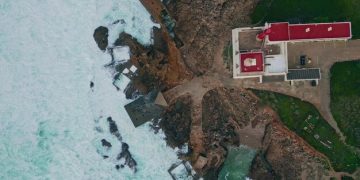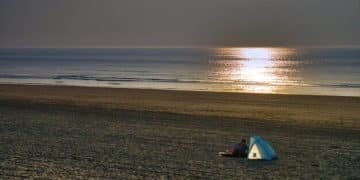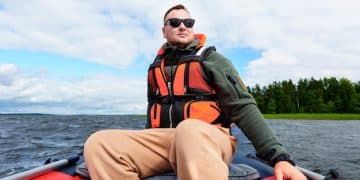Coastal Erosion Awareness: Protect Our Beaches and Shorelines

Coastal erosion awareness is crucial for understanding how natural forces and human activities impact beaches, leading to habitat loss and economic damage, and for taking action to mitigate these effects.
Coastal erosion awareness: Understanding the impact on beaches and how to help is essential for preserving our shorelines. Coastal erosion is a natural process exacerbated by human activities, threatening our beaches, coastal communities, and ecosystems. This article will explore the causes and impacts of coastal erosion, as well as practical steps we can all take to protect our valuable coastlines.
What is Coastal Erosion and Why is it Happening?
Coastal erosion is the wearing away of land and the removal of sediments along the coastline due to wave action, tidal currents, wind, water runoff, and human activities. It is a natural process, but its rate and severity have increased dramatically in recent decades.
Several factors contribute to coastal erosion. Natural forces such as storms, sea-level rise, and geological changes play a significant role. However, human activities, including construction, deforestation, and pollution, can exacerbate these processes, leading to faster and more extensive erosion.
Natural Causes of Coastal Erosion
Natural processes are significant drivers of coastal erosion. These include:
- Wave Action: Waves pound the shoreline, gradually wearing away the land. The energy of the waves is especially potent during storms.
- Tidal Currents: Tides can carry away sediments, especially in areas with strong tidal flows.
- Sea-Level Rise: Rising sea levels inundate low-lying areas and increase the reach of waves, leading to increased erosion.
- Geological Changes: The natural sinking or rising of landmasses can alter coastlines and affect erosion rates.
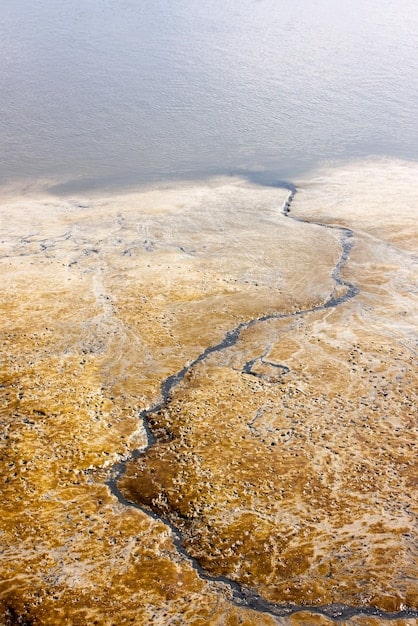
Human Activities That Exacerbate Coastal Erosion
Human actions can greatly accelerate coastal erosion. Some of the main culprits include:
- Construction: Building structures along the coast can disrupt natural sediment transport and lead to increased erosion in adjacent areas.
- Deforestation: Removing trees and vegetation destabilizes the soil, making it easier for waves and wind to erode the land.
- Pollution: Pollution can damage coastal ecosystems, such as mangrove forests and coral reefs, which provide natural protection against erosion.
In conclusion, coastal erosion is driven by a combination of natural processes and human activities. Understanding these causes is the first step in developing strategies to mitigate its impacts and protect our coastlines.
The Impact of Coastal Erosion on Beaches
The impact of coastal erosion on beaches is far-reaching, affecting not only the natural environment but also the economy and the well-being of coastal communities. Beaches are dynamic ecosystems that provide habitats for numerous species, protect inland areas from storms, and offer recreational opportunities for millions of people.
Beach loss is one of the most visible consequences of coastal erosion. As the shoreline recedes, valuable recreational space disappears, impacting tourism and local economies. In addition, coastal erosion can lead to habitat loss, threatening coastal ecosystems and the species that depend on them.
Economic Consequences of Beach Erosion
The economic impacts of beach erosion are significant. These include:
- Decline in Tourism: Eroded beaches are less attractive to tourists, leading to a decrease in visitor numbers and revenue for local businesses.
- Property Damage: Coastal erosion can threaten homes, businesses, and infrastructure, leading to costly repairs or even complete loss.
- Increased Costs for Coastal Protection: Protecting eroding coastlines requires investment in engineered structures such as seawalls and breakwaters, which can be expensive.
Environmental Consequences of Beach Erosion
The environmental impacts of beach erosion are equally concerning. These include:
- Habitat Loss: As beaches erode, habitats for shorebirds, sea turtles, and other coastal species disappear.
- Loss of Biodiversity: The decline in habitats can lead to a loss of biodiversity, disrupting coastal ecosystems.
- Increased Vulnerability to Storms: Eroded beaches provide less protection against storms, increasing the risk of flooding and damage to inland areas.
In conclusion, coastal erosion has profound economic and environmental consequences, impacting coastal communities and ecosystems. Addressing this issue requires a comprehensive approach that considers both the immediate and long-term effects of erosion.
How Sea-Level Rise Affects Coastal Erosion
Sea-level rise is a major driver of coastal erosion, exacerbating its effects on beaches and coastal communities. As the global average sea level rises due to climate change, the impact on coastal areas becomes increasingly pronounced.
Rising sea levels increase the frequency and intensity of coastal flooding, leading to greater erosion. The higher water levels also allow waves to reach further inland, eroding beaches and damaging coastal infrastructure. The combination of sea-level rise and storm surges can be particularly devastating.
The Science Behind Sea-Level Rise
Sea-level rise is primarily caused by two factors:
- Thermal Expansion: As ocean water warms, it expands, increasing the volume of the ocean.
- Melting of Ice: The melting of glaciers and ice sheets adds water to the ocean, further raising sea levels.
Strategies for Adapting to Sea-Level Rise
Adapting to sea-level rise requires a combination of strategies. These include:
- Managed Retreat: Moving development away from vulnerable coastal areas to reduce the risk of damage and erosion.
- Coastal Protection: Constructing engineered structures such as seawalls and breakwaters to protect coastlines from erosion and flooding.
- Natural Defenses: Restoring or enhancing natural coastal habitats, such as mangrove forests and dunes, to provide natural protection against erosion.
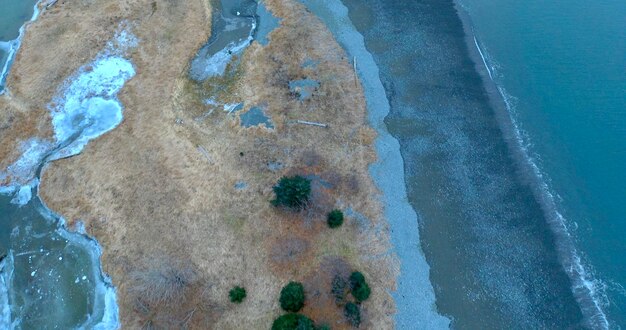
In conclusion, sea-level rise is a critical factor in coastal erosion, increasing its severity and impact on coastal areas. Adapting to sea-level rise requires a comprehensive approach that includes managed retreat, coastal protection, and the restoration of natural defenses.
Protecting Beaches: Hard and Soft Engineering Solutions
Protecting beaches from coastal erosion requires a combination of strategies, including both hard and soft engineering solutions. Hard engineering solutions involve constructing physical structures to protect the coastline, while soft engineering solutions focus on natural methods to stabilize and restore beaches.
Hard engineering solutions such as seawalls, breakwaters, and groins can provide immediate protection against erosion. However, these structures can also have negative impacts on the environment, disrupting natural sediment transport and altering coastal ecosystems. Soft engineering solutions, such as beach nourishment, dune restoration, and the planting of vegetation, offer more sustainable and environmentally friendly alternatives.
Hard Engineering Solutions
Hard engineering solutions include:
- Seawalls: Walls built along the coastline to protect inland areas from wave action.
- Breakwaters: Offshore structures designed to reduce wave energy and protect beaches from erosion.
- Groins: Structures built perpendicular to the shoreline to trap sand and prevent erosion.
These hard engineering solutions can effectively protect specific areas from erosion. However, they can also have unintended consequences, such as increased erosion in adjacent areas.
Soft Engineering Solutions
Soft engineering solutions include:
- Beach Nourishment: Adding sand to eroded beaches to restore their width and protect inland areas.
- Dune Restoration: Restoring or enhancing dunes to provide a natural barrier against storm surges and erosion.
- Vegetation Planting: Planting vegetation along the coastline to stabilize the soil and prevent erosion.
Soft engineering solutions offer more sustainable and environmentally friendly alternatives to hard engineering. These methods work with natural processes to protect and restore beaches, providing long-term benefits for coastal ecosystems and communities.
In conclusion, protecting beaches from coastal erosion requires a balanced approach that considers both hard and soft engineering solutions. While hard engineering can provide immediate protection, soft engineering offers more sustainable and environmentally friendly alternatives.
Community Involvement: How to Help Combat Coastal Erosion
Community involvement is essential for combating coastal erosion and protecting our beaches. Local communities play a critical role in raising awareness, advocating for policy changes, and implementing conservation efforts.
Individuals, organizations, and local governments can all contribute to protecting coastlines. By working together, communities can develop and implement effective strategies to mitigate the impacts of coastal erosion and ensure the long-term health of our beaches.
Individual Actions
Individuals can take several actions to help combat coastal erosion. These include:
- Reducing Your Carbon Footprint: By reducing your carbon footprint, you can help slow down climate change and sea-level rise, which are major drivers of coastal erosion.
- Supporting Sustainable Development: Supporting sustainable development practices can help minimize the impacts of human activities on coastal ecosystems.
- Participating in Beach Cleanups: Participating in beach cleanups can help remove debris and protect coastal habitats.
Community Initiatives
Communities can organize a variety of initiatives to combat coastal erosion. These include:
- Educational Programs: Educating the public about coastal erosion and its impacts can raise awareness and promote responsible behavior.
- Advocacy Efforts: Advocating for policy changes that protect coastal resources can help prevent further erosion.
- Conservation Projects: Implementing conservation projects, such as dune restoration and vegetation planting, can help stabilize and restore beaches.
In conclusion, community involvement is crucial for combating coastal erosion and protecting our beaches. By working together, individuals, organizations, and local governments can make a significant difference in preserving our coastlines for future generations.
The Role of Policy and Regulations in Coastal Erosion Management
Policy and regulations play a crucial role in coastal erosion management, providing a framework for protecting coastal resources and mitigating the impacts of erosion. Effective policies and regulations can help prevent unsustainable development, promote responsible behavior, and ensure the long-term health of our coastlines.
Governments at all levels can implement policies and regulations to address coastal erosion. These can include zoning regulations, building codes, environmental protection laws, and coastal management plans. By creating a comprehensive and enforceable regulatory framework, governments can help protect coastal communities and ecosystems from the impacts of erosion.
Key Policy Measures
Key policy measures for coastal erosion management include:
- Zoning Regulations: Zoning regulations can restrict development in vulnerable coastal areas, reducing the risk of damage and erosion.
- Building Codes: Building codes can require new construction to be designed to withstand the impacts of coastal erosion and flooding.
- Environmental Protection Laws: Environmental protection laws can protect coastal ecosystems, such as mangrove forests and coral reefs, which provide natural protection against erosion.
International Agreements
International agreements also play a role in addressing coastal erosion. These agreements can promote cooperation between countries to address climate change and sea-level rise, which are major drivers of coastal erosion.
- Paris Agreement: The Paris Agreement is an international agreement aimed at reducing greenhouse gas emissions and limiting global warming.
- Sustainable Development Goals: The Sustainable Development Goals (SDGs) are a set of global goals aimed at achieving sustainable development by 2030. SDG 14, Life Below Water, focuses on protecting and conserving marine resources.
In conclusion, policy and regulations are essential for coastal erosion management. By implementing effective policies and regulations, governments can help protect coastal communities and ecosystems from the impacts of erosion and ensure the long-term health of our coastlines.
| Key Point | Brief Description |
|---|---|
| 🌊 Coastal Erosion | The wearing away of land due to wave action, tidal currents, and human activities. |
| 📉 Economic Impact | Decline in tourism, property damage, and increased costs for coastal protection. |
| 🛡️ Protective Measures | Hard (seawalls) and soft (beach nourishment) engineering solutions. |
| 🤝 Community Action | Individual actions and community initiatives like beach cleanups. |
Frequently Asked Questions (FAQ)
▼
Coastal erosion is primarily caused by natural forces such as wave action and sea-level rise, exacerbated by human activities like construction and deforestation, which destabilize the coastline.
▼
Sea-level rise increases the frequency and intensity of coastal flooding, allowing waves to reach further inland, eroding beaches, and damaging coastal infrastructure more extensively than before.
▼
Soft engineering solutions include beach nourishment (adding sand to eroded beaches), dune restoration, and planting vegetation along coastlines to naturally stabilize the soil and prevent erosion.
▼
Individuals can reduce their carbon footprint, support sustainable development, participate in beach cleanups, and educate others about the importance of protecting coastal environments and resources.
▼
Community involvement is crucial for raising awareness, advocating for policy changes, and implementing conservation efforts, ensuring that local perspectives and needs are addressed effectively.
Conclusion
Coastal erosion awareness: Understanding the impact on beaches and how to help is critical for safeguarding our valuable coastlines. By understanding the causes and impacts of coastal erosion, supporting protective measures, and engaging in community efforts, we can collectively preserve our beaches for future generations.
